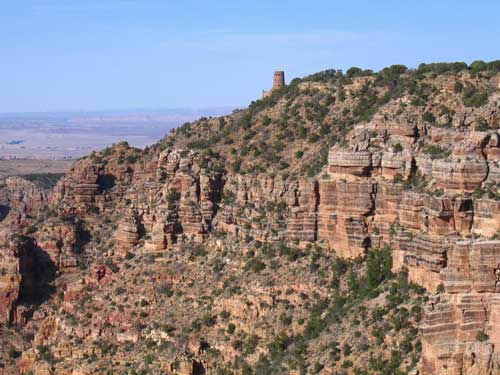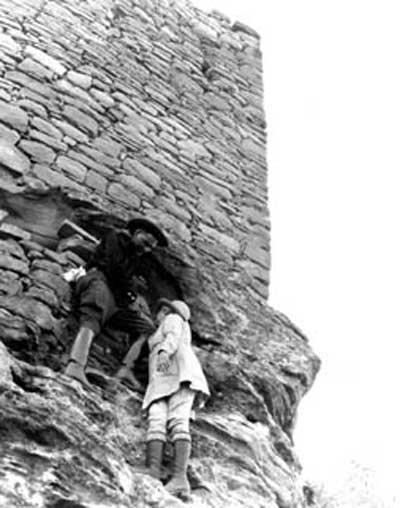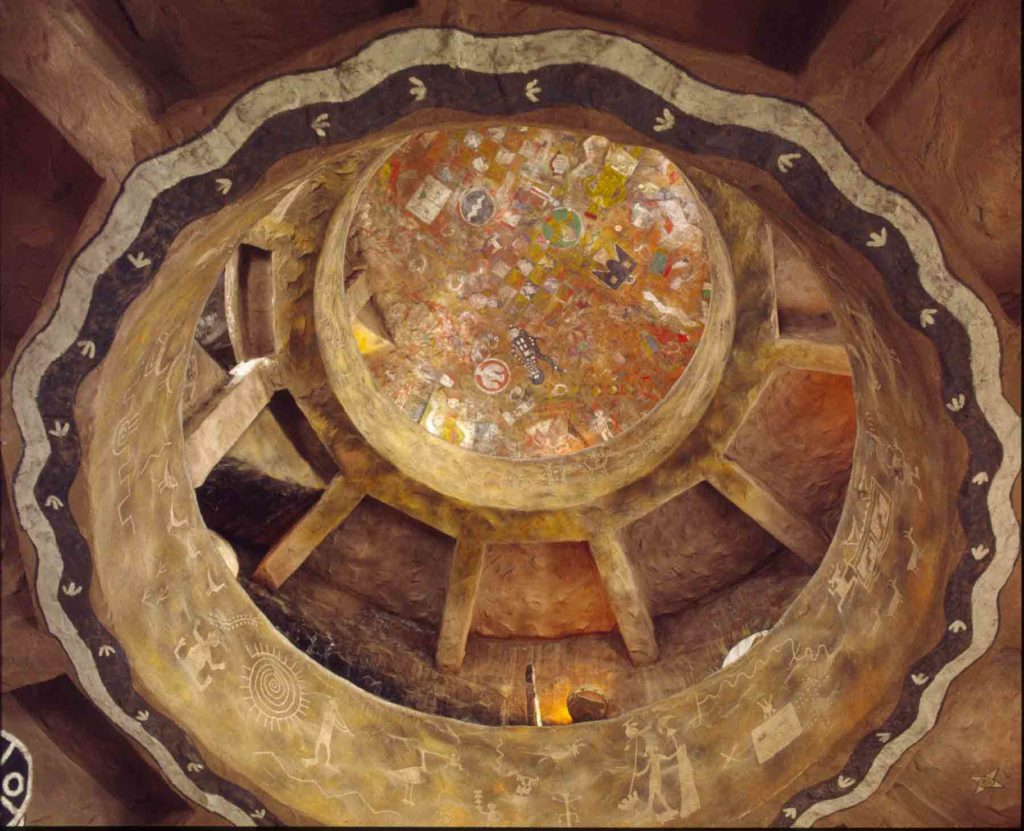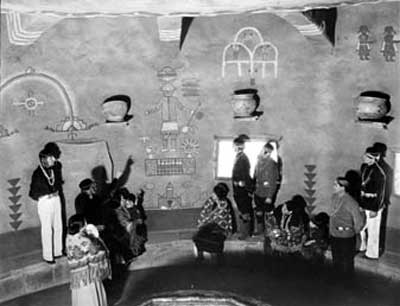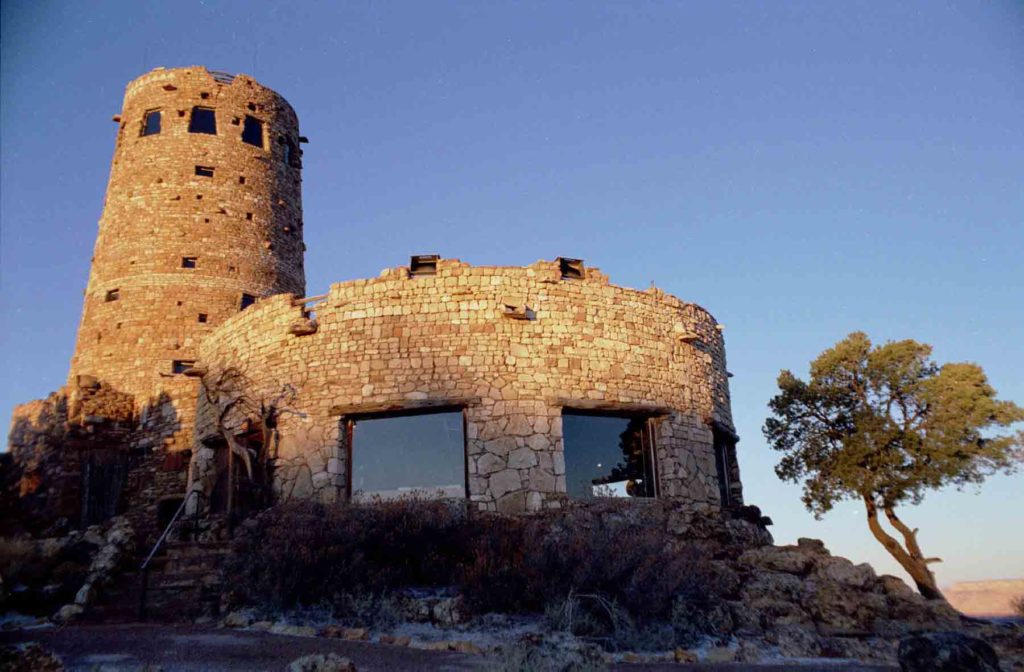Near the eastern edge of Grand Canyon National Park, where the Colorado River begins to turn north and the Painted Desert stretches toward the Navajo and Hopi Reservations, a 70-foot-tall circular stone structure perched on the South Rim draws visitors’ attention. What at first glance appears to be an ancient Native American ruin, made with reddish sandstone, this tallest structure on the South Rim is actually a well-planned, relatively modern building that architect Mary Colter designed for the Fred Harvey Company.
Although the Great Depression slowed tourism at the Grand Canyon somewhat, the Fred Harvey Company continued to look for ways to expand its services and economic opportunities. The Desert View Watchtower was one of several construction projects the Company initiated in the 1930s, many of them Colter designs. Like Hopi House, another Grand Canyon structure that Colter developed for Fred Harvey, this building played into the Company’s reputation as a purveyor and promoter of Native American arts, crafts, and culture.
Always fascinated by Native American cultures, Colter carefully studied indigenous building techniques and the natural materials they used. She investigated ancient Puebloan ruins, and dabbled in learning about Hopi culture. These influences all came into play when she planned the Watchtower. For decades archaeologists had studied ancient stone ruins in the Four Corners region that, from their Euro-American cultural background, seemed to resemble fortresses or lookout towers, or perhaps astronomical observatories. Although there is no evidence that a similar structure ever existed in the Grand Canyon area, in Colter’s mind the rim of the Canyon was a perfect location for this type of feature. It is not a replica of any real tower, but her interpretation of the architecture and culture of Southwestern Native American groups.
Colter designed the Watchtower using a steel frame around which carefully selected stones were placed. Completed in 1932, the Watchtower was a combination tourist attraction, curio shop, and museum of Hopi culture and symbolism. Next to the four-story tower is a circular structure meant to resemble a kiva, a ceremonial room used in the spiritual practices of many Puebloan groups. Inside this kiva structure, the Fred Harvey Company even today sells souvenirs and Native American arts and crafts. It features several “reflectoscopes.” These are sheets of black glass or onyx that reflect images like a mirror. The reflectoscope was invented by Claude Lorrain, a 17th Century French landscape painter, because the dark glass makes colors appear more vivid. Visitors can use them to gain an unusual view of the Canyon’s colorful rock features.
Each story of the Watchtower has several windows that allow visitors to gain different views of the Canyon and the surrounding area. The first floor displays a Hopi snake altar. The walls and ceiling are covered in Native American symbols and pictographs. This includes a mural of the Hopi Snake Legend by Hopi artist Fred Kabotie that describes their cultural connection to the Grand Canyon. This painting tells the story of a Hopi man who floated down the Colorado River through the canyon in a hollow log.
However, representatives from the Fred Harvey Company’s Indian Department chose what other symbols to include. Colter and others decided to use the most compelling or unusual images that they had seen at a range of sites that related to a number of different Native American tribes. Therefore, while some of these symbols are indigenous to the Grand Canyon, others might be completely unassociated with the area. For example, a double lightning symbol that appears on the first parapet was copied from a petroglyph in Petrified Forest National Park, as are images of hunters, animals, and spirals found throughout the watchtower’s interior.
To celebrate the opening of the Watchtower, the Fred Harvey Company planned a dedication that included a traditional Hopi kiva blessing ceremony, Native American singing and dancing, and speeches. After the ceremony, guests were fed a traditional Hopi meal as women demonstrated how to grind cornmeal on metates and cook traditional piki bread. Eleanor Oesdean, who was born at the Grand Canyon and lived there for much of her childhood, remembered that she and other Euro-Americans dressed up in Native American-style clothing and jewelry for the occasion.
Not everyone was pleased with the new structure. National Park Service personnel were split in their opinion of it. Superintendent Miner Tillotson supported its construction, while most of the interpretive staff disliked it. Chief Naturalist Edwin McKee thought that it stuck out from the landscape like a sore thumb, and felt that the way the Fred Harvey Company called it an “Indian Watchtower” was misleading. Over the years the NPS came up with many different proposals for what to do with the Watchtower, from tearing it down to converting it into an NPS visitor center. Today it remains standing and in concessionaire hands. The Desert View Watchtower, with its blend of Native American and Euro-American cultural symbols and ideas that all draw from the local environment, still serves as an example of how different cultures can collide in interesting ways.
Written By Sarah Bohl Gerke
References:
- Anderson, Michael F. Polishing the Jewel: An Administrative History of Grand Canyon National Park. GCA, 2000.
- Anderson, Michael F. Along the Rim: A Guide to Grand Canyon’s South Rim from Hermit’s Rest to Desert View. GCA, 2001.
- Grattan, Virginia L. Mary Colter: Builder Upon the Red Earth. Grand Canyon Natural History Association, 1992.

